Abstract
Titanium is known to be an indispensable element in biomaterials. In this study, boron carbide was considered as an alternative to titanium due to its good mechanical properties. Boron carbide has high temperature resistance, high wear resistance, etc. It is a preferred material due to its properties. Considering this information, different compositions were created by mixing Fe–B4C and egg shell powders. Compositions sintered using powder metallurgy technique were investigated mechanically, physically and metallographically. According to the results of the analysis, it was determined that the hardness increased by 13.75% with the addition of egg shell. The hardness value of 204.12 HB was measured in the sample sintered at 1,400°C by adding 6.66% egg shelter powder.
1 Introduction
The expected properties of materials to be used in industrial applications are generally low cost, strength, toughness and lightness. Strength in conventional materials can be increased by heat treatment. However, it is not possible to have all of the properties such as impact resistance, abrasion resistance, toughness and lightness together in conventional materials at the same time. These developments, on the other hand, are added to the metal matrix, thanks to the micro- or nano-sized reinforcements [1]. The physical, mechanical and also radiation shielding properties were achieved in metal matrix composite [2,3,4,5,6,7,8,9,10,11,12,13,14,15,16,17,18,19,20,21,22,23,24,25,26,27,28,29,30]. In powder metallurgy method, metal powders are mixed, at room temperature or at elevated temperatures, in the mold with the shape and dimensions of the part to be produced. It is a manufacturing method performed by pressing, forming and then sintering at a certain temperature [31,32,33]. As a first goal in research on agricultural wastes, it is concerned with the use or effective evaluation of the energy potential of wastes [34]. Metal materials are also used to facilitate the machinability of ceramic materials. Direct fabrication methods have been tried to be developed for the production of high-strength ceramic materials [33].
Recently, research has been carried out on the improvement of the mechanical properties of the materials with the lightening of the materials and the production of new materials by evaluating the wastes. Research on agricultural wastes is concerned with the use or effective evaluation of the energy potential of wastes as the first target. It has been stated that the use of egg shell powders in the production of metal matrix composites improves mechanical properties [35,36,37,38,39].
It is thrown into the environment after use. Excipient from egg shells is used as a base material for the development of medicine and dental implants or as a food additive and calcium supplement, a component of agricultural fertilizers and an ingredient for bone implants. Still a significant amount of egg shell is considered as waste [39].
The aim of this study was to investigate the physical, mechanical and metallographic effects of the egg shell powders added in the production of metal matrix–ceramic composites, and the produced samples were characterized.
2 Materials and methods
Metallic powder properties used in this study are given as follows. Fe powders with 99.8% purity and a particle size of less than 70 μm were obtained from Sigma Aldrich. B4C powders with 99.9% purity and a particle size of less than 100 μm from egg shelter powders were used. Powder samples with composition of 98.33% Fe–1.66% B4C, 96.66% Fe–1.66% B4C–1.66% egg shelter, 95% Fe–1.66% B4C–3.32% egg shelter, 93.33% Fe–1.66% B4C–5% egg shelter and 91.66% Fe–1.66% B4C–6.66% egg shelter were prepared. Powder samples were shaped with 30 g circular uniaxial press. After weighing, the composition mixture was mixed in a mixer for 24 h to ensure that the composition was homogeneous. The mixture was shaped by uniaxial cold hydraulic pressing using a high-strength steel mold. It was carried out under a pressure of 400 bar to compress all powder mixtures. Cold pressed samples were sintered at 1,400°C for 2 h in a conventional tube oven using an argon gas atmosphere. After sintering, the samples were allowed to cool naturally under argon atmosphere in the oven. Microhardness and shear strength of the samples were measured by METTEST-HT (Vickers) microhardness tester, respectively. LEO 1430 VP equipped with the Oxford EDX analyzer in TUAM was used for SEM microstructure and EDX analysis as a scanning electron microscope.
The density changes of the composite samples produced in 98.33%Fe–1.66% B4C, 96.66% Fe–1.66% B4C–1.66% egg shelter, 95% Fe–1.66% B4C–3.32% egg shelter, 93.33% Fe–1.66% B4C–5% egg shelter and 91.66% Fe–1.66% B4C–6.66% egg shelter composites were calculated using the sintering composite samples (d = m/V) formula (Figure 1). The volume of sintered samples was measured by the Archimedes principle. All percentages and ratios were given in percent by weight. The minerals contained in the egg shell powders were analyzed and reported in previous study [40].
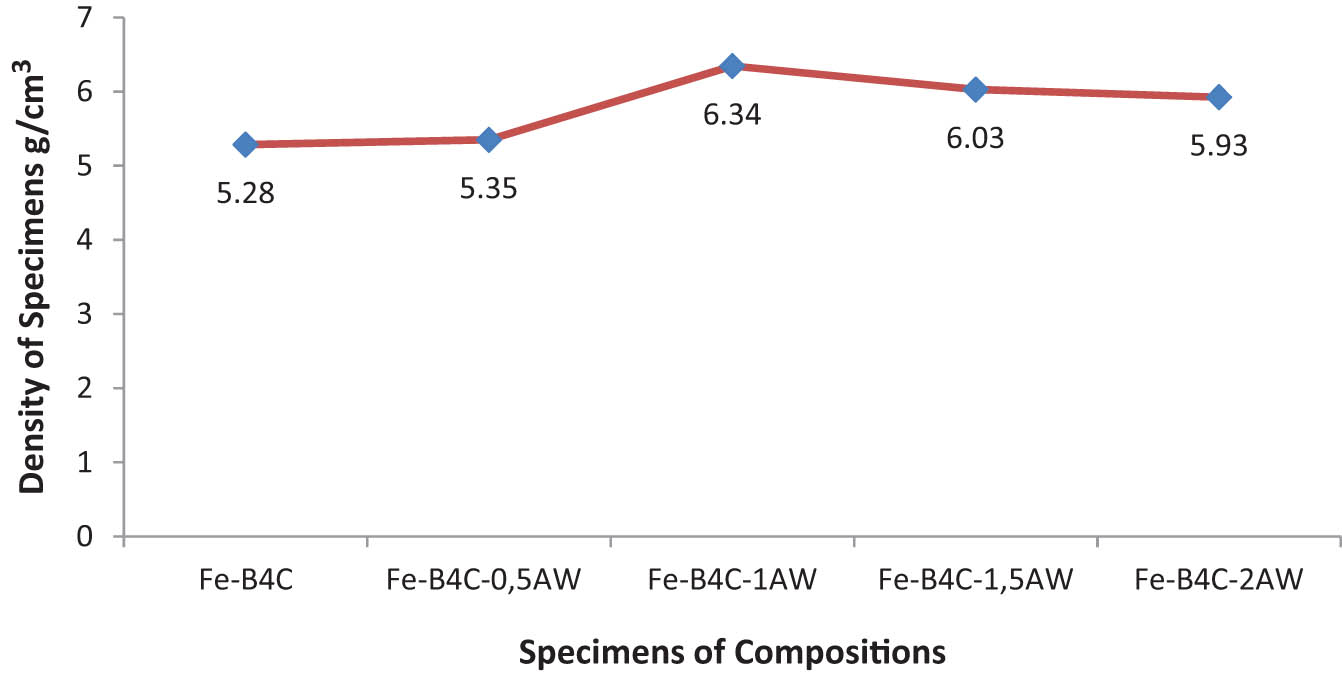
Composition–density change curve of ceramic–metal composite.
3 Experimental results and discussion
3.1 Characterization of specimens
The density–composition graph of the composite samples produced with metal matrix and ceramic additives is given in Figure 1. In the production of composite samples, the additive of egg shell powders was used atomically at different rates between 0 and 6.66% . The density was calculated as 5.28 g/cm3 when egg shell powder was not added in the produced composite. When the egg shell powder was added up to 6.66% atomically, the density value was calculated as 5.93 g/cm3. It was observed in SEM images that the addition of egg shell powder reduced the porosity in the composite.
The hardness values measured in the samples produced in Figure 2 were measured from ten different points and given by taking the average. The lowest hardness value of 178.25 HB was measured in the composite sample without adding egg shell powder. Different compositions were obtained by increasing the egg shell powder atomically up to 6.66% in the sample composition. Among the produced samples, the highest hardness value was measured in the sample belonging to 204.12 HB and 91.66% Fe–1.66% B4C–6.66% composition.
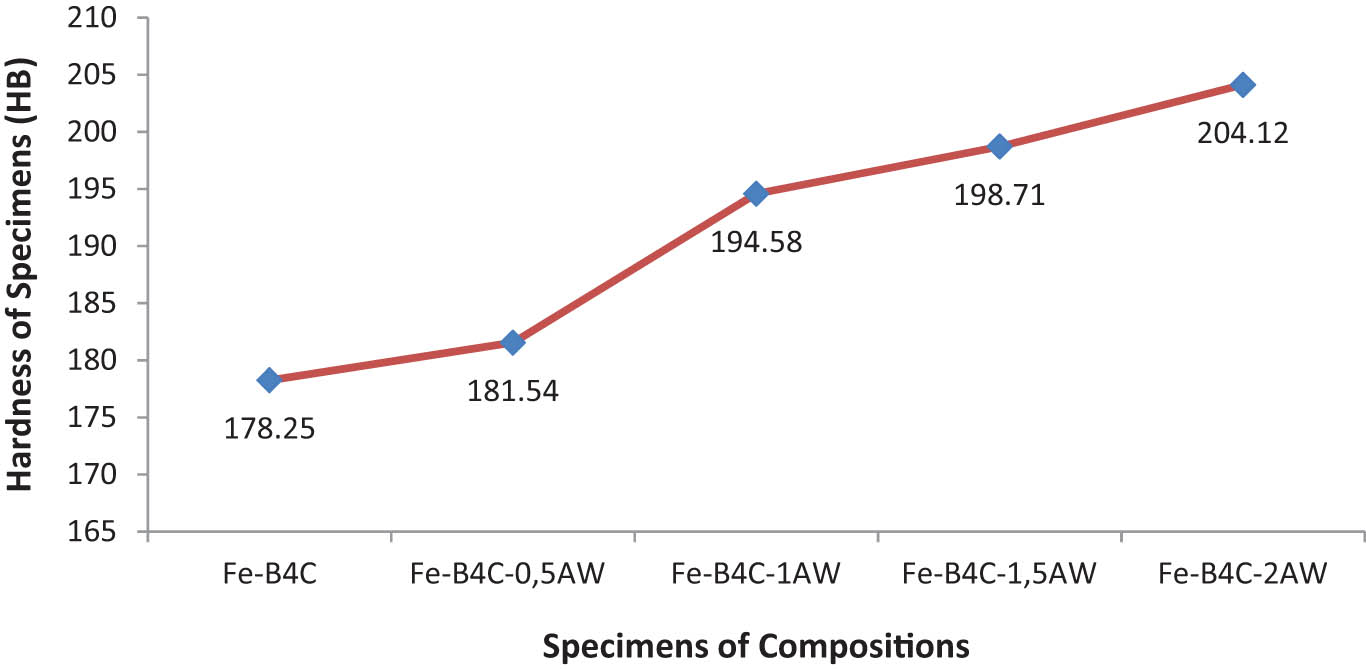
Composition–hardness change curve of ceramic–metal composite.
4 Metallographic analysis
In Figure 3, the microstructure of the Fe–B4C composite sample sintered at 140°C produced without adding egg shell powder is given in the SEM picture. It is seen that B4C is homogeneously distributed in the microstructure. It is understood that intergranular neck formation takes place. In addition, it is seen that the porosity in the microstructure is higher than the samples with egg shelter powder added. The hardness and density values of this sample also confirm the excess of porosity.
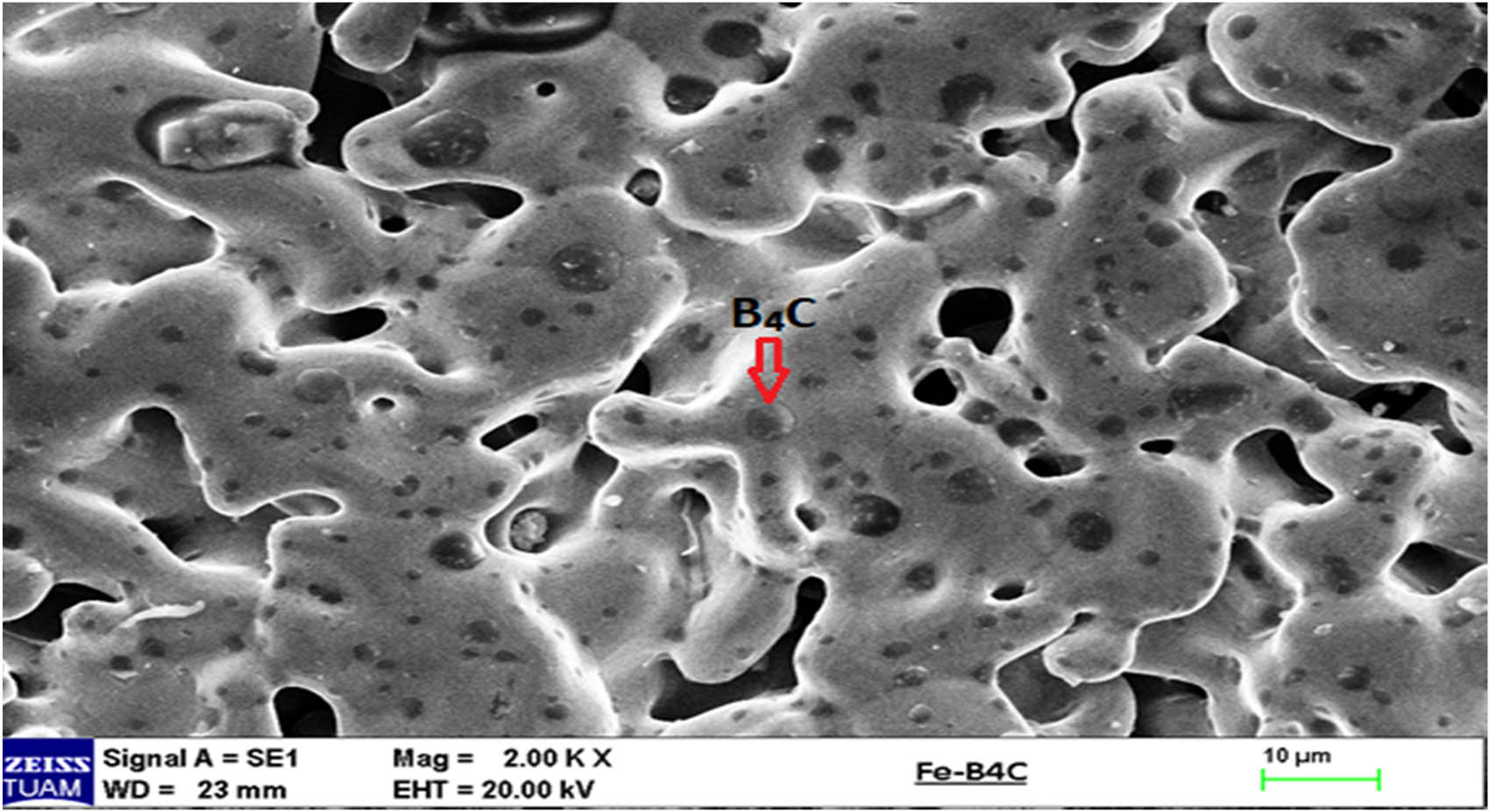
SEM picture of Fe–B4C composite.
In Figure 4, the microstructure of the 96.66% Fe–1.66% B4C–1.66% egg shelter sample sintered at 1,400°C by adding egg shelter powder is given. It is seen that the B4C particles in the microstructure maintain their homogeneous distribution in Fe, where the appearance is reduced. It is understood that intergranular neck formation takes place. In addition, it is seen that the porosity in the microstructure is less than the sample without egg shelter powders. The hardness and density values of this sample also confirm that the porosity is less than the sample without egg shelter powders.
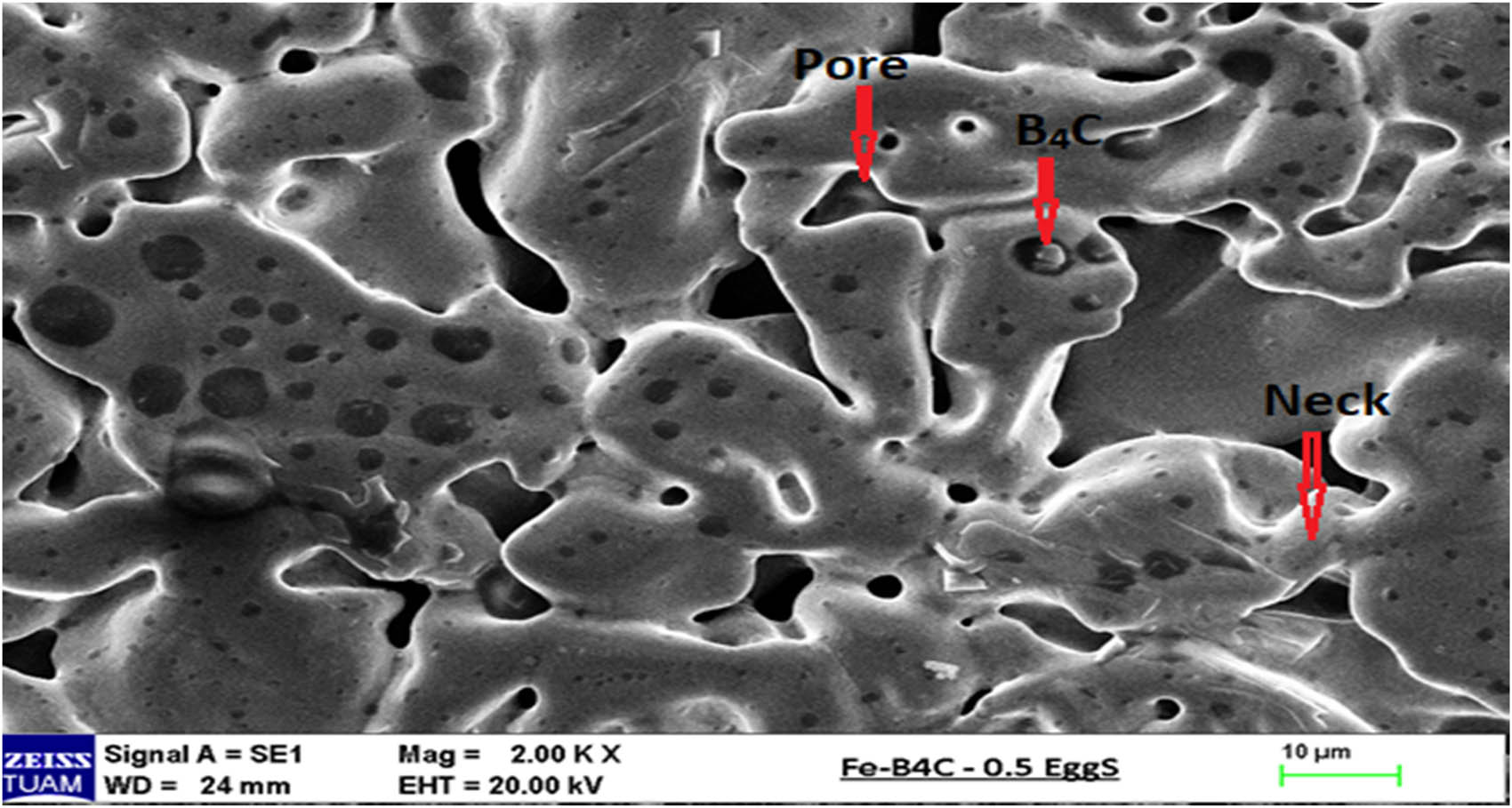
SEM picture of 96.66% Fe–1.66% B4C–1.66% egg shelter.
In Figure 5, the microstructure of the 95% Fe–1.66% B4C–3.32% egg shelter composite sample sintered at 1,400°C is given in the SEM picture. It is seen that the appearance of B4C particles in Fe in the microstructure decreases and starts to disappear. Porosity decreased due to grain coarsening in the sample of this composition. It turns out that sintering takes place much better. Grain boundaries are clearly observed in the microstructure. The hardness and density data of this sample also confirm the microstructure properties.
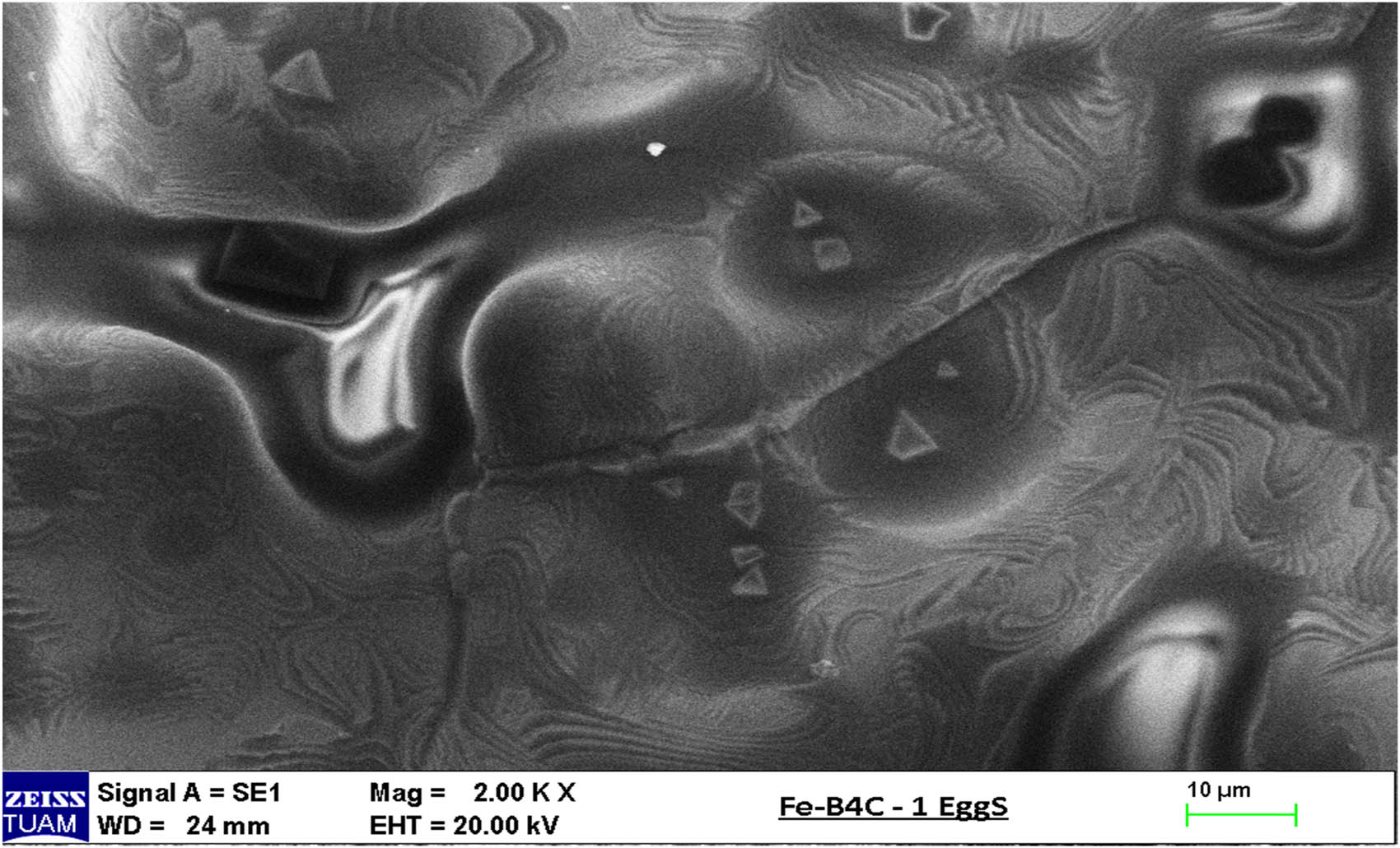
SEM picture of 95% Fe–1.66% B4C–3.32 egg shelter.
In Figure 6, the microstructure of the 93.33% Fe–1.66% B4C–5% egg shelter composite sample sintered at 1,400°C is given in the SEM picture. It is seen that B4C particles and egg shell powders in the microstructure disappear in Fe and turn into gray and black colors. Acicular particles are seen in the microstructure. In the sample of this composition, the porosity decreased a lot with grain coarsening. It is understood that sintering takes place much better in this composition. Grain boundaries are clearly observed in the microstructure.
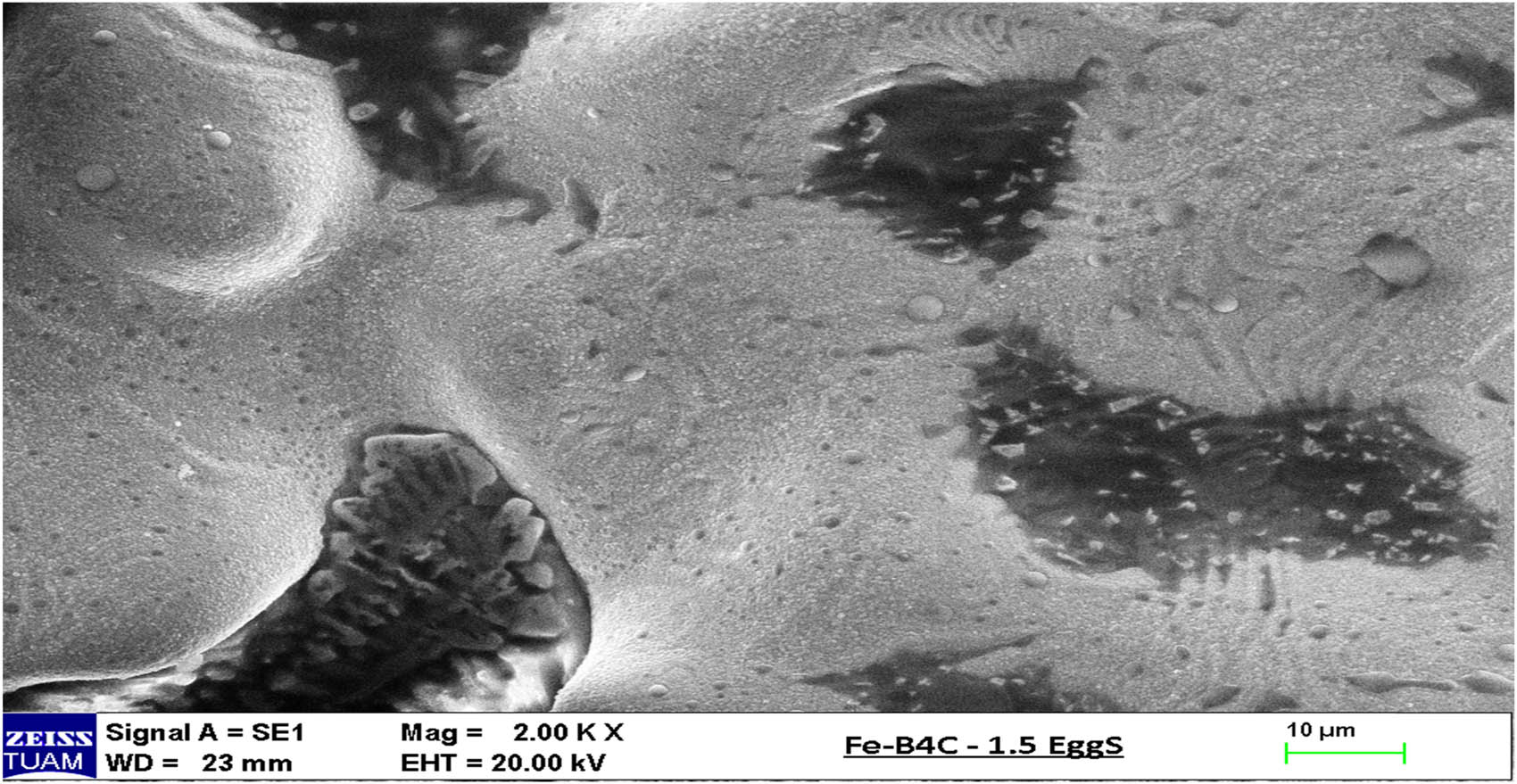
SEM picture of 93.33% Fe–1.66% B4C–5% egg shelter.
In Figure 7, the microstructure of the 91.66% Fe–1.66% B4C–6.66% egg shelter composite sample sintered at 1,400°C is given in the SEM picture. In addition to the homogeneous distribution of the microstructure, it is observed that it turns into gray and black colors. Acicular particles are seen in the microstructure. The co-porosity in the sample of this composition was much reduced compared to the other compositions. It is understood that the sintering that takes place in this composition takes place much better than other compositions. The highest hardness value was measured in this composition.
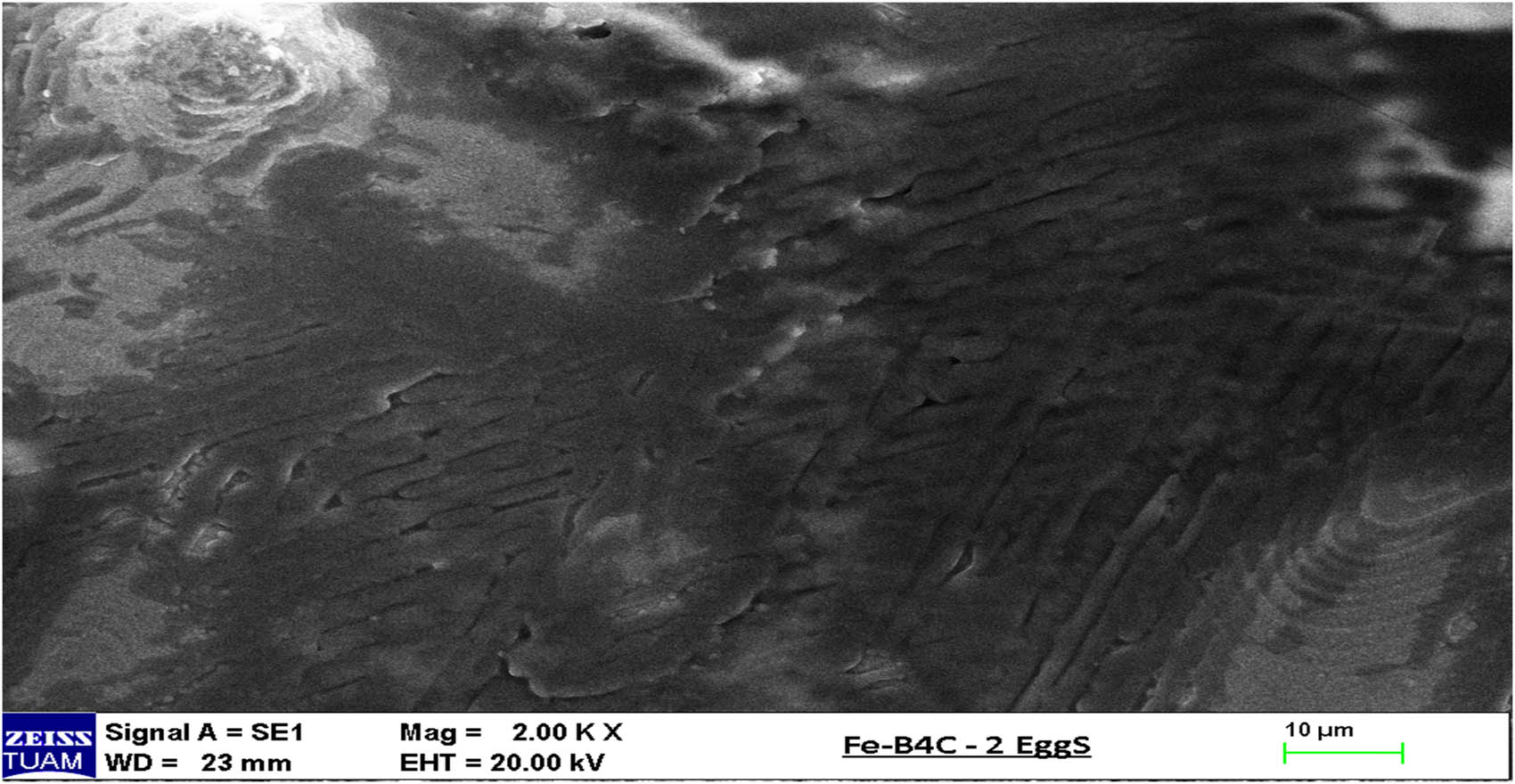
SEM picture of 91.66% Fe–1.66% B4C–6.66% egg shelter.
In Figure 8, EDX analysis of the sample of the composition with 1.66% egg shell powder added was made linearly. Fe, Al, Si, Mn and C elements were determined in the sample. Intergranular neck formation is seen in the SEM image. In addition, it is clearly seen in the micro-structured pores.
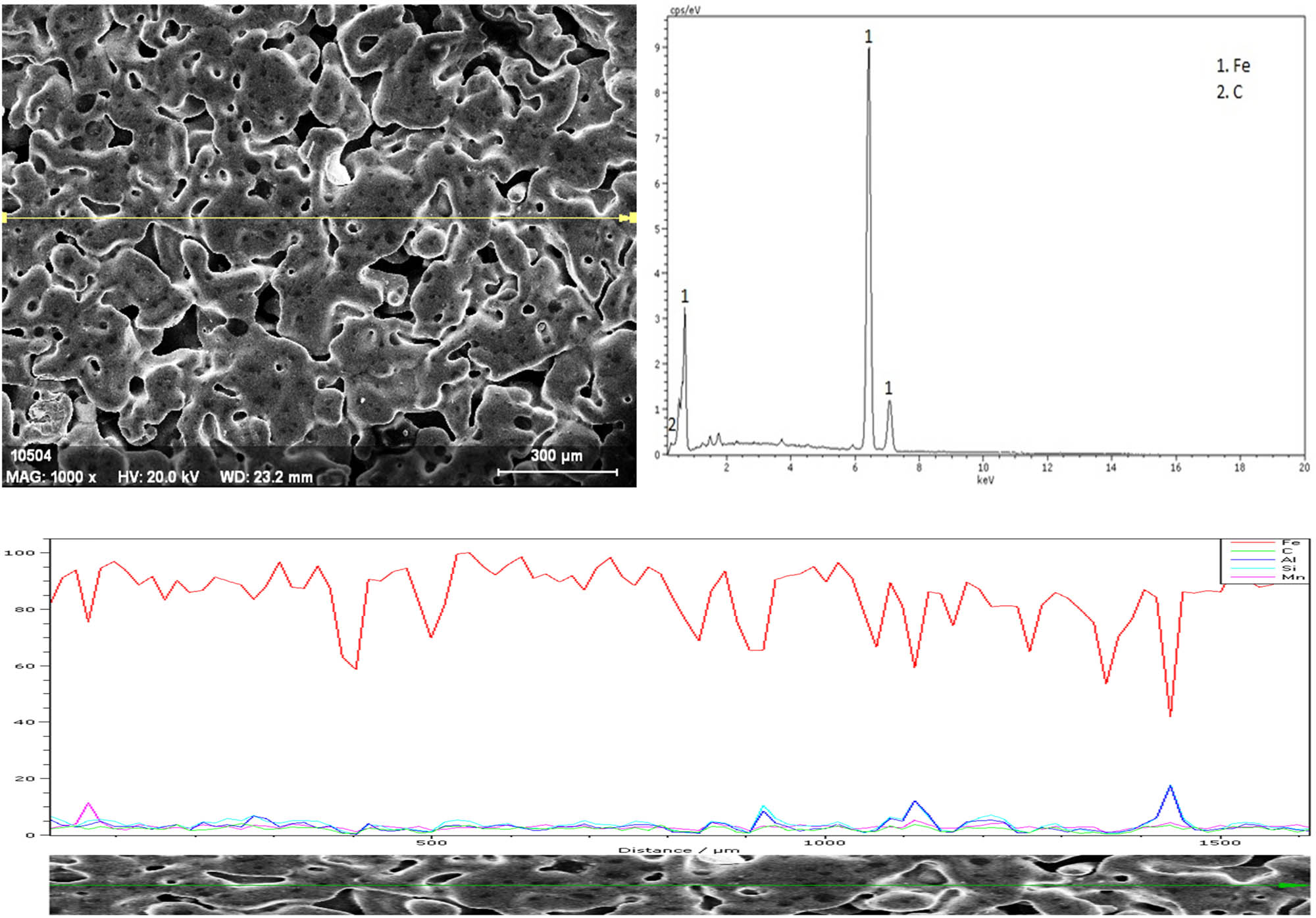
EDX analysis of 98.33% Fe–1.66% B4C composite.
In Figure 9, EDX analysis of the sample of the composition to which 6.66% egg shell powder was added was performed linearly. Fe, Al, Mg and Ca elements were determined in the sample. Intergranular neck formation is seen in the SEM image. It was observed that the microstructure of the sample, in which the egg shell powder additive was 6.66%, decreased significantly. The decrease in porosity is confirmed by the increase in hardness value.
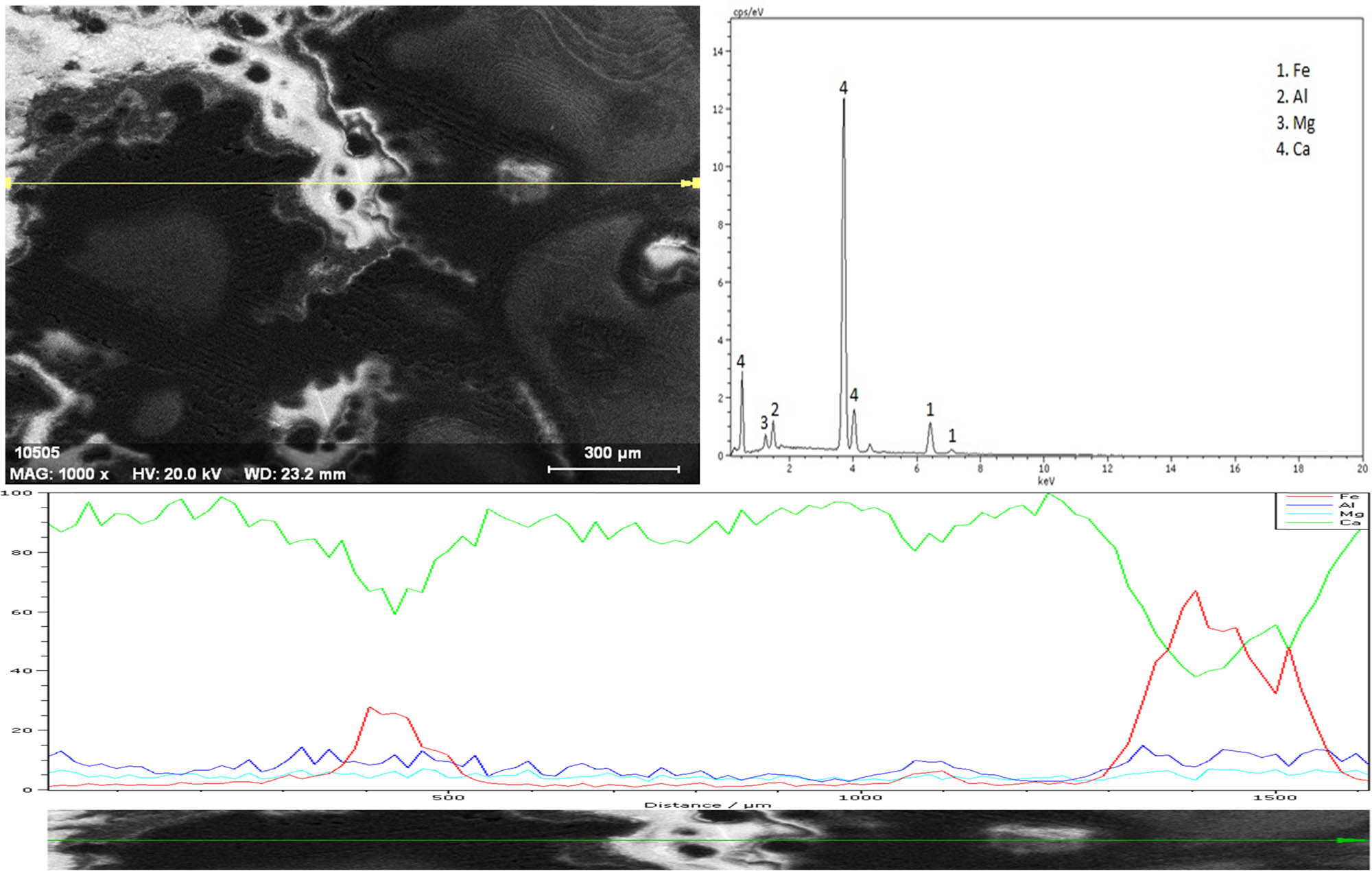
EDX analysis of Fe–B4C–6.66% egg shelter.
In Figure 10, X-ray analysis results of the sample belonging to the composition of 98.33% Fe–1.66% B4C are given. According to the results of the analysis, the phases formed were determined as Fe, B4C, Al, Mg and Ca. The lowest density and hardness were measured in this composition. By adding egg shell powders to the composition, improvements were achieved in the material microstructure and mechanical properties.
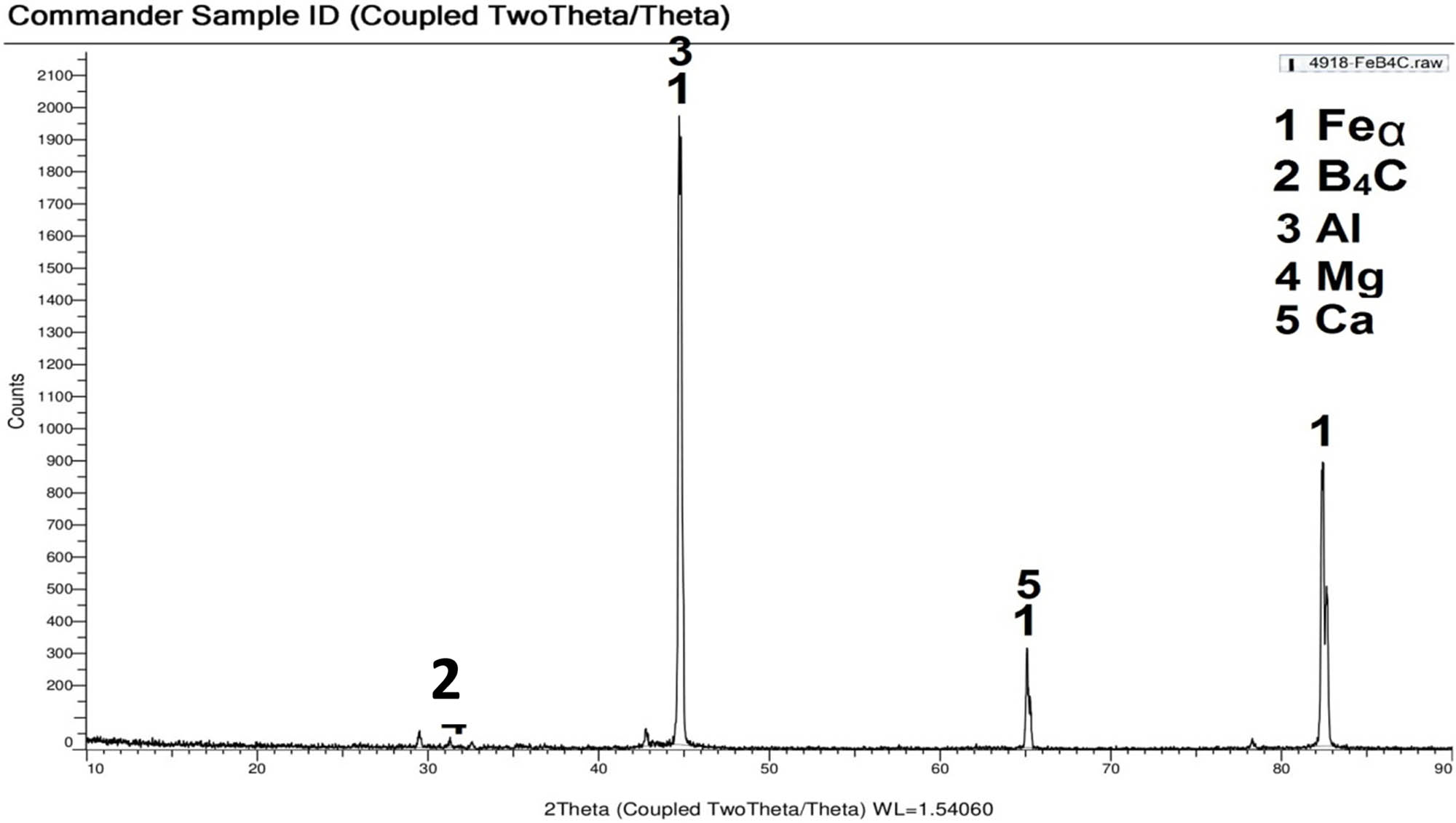
XRD analysis of 98.33% Fe–1.66% B4C composite.
In Figure 11, X-ray analysis results of the sample of 91.66% Fe–1.66% B4C–6.66% eggS composition are given. According to the results of the analysis, the phases formed were determined as Fe, B4C, Al, Mg and CaO, respectively. The formation of the Fe2B phase is thought to be effective in increasing the hardness. Unlike the phases formed in the sample without egg shell powders, a peak of Fe2B and CaO phases was formed.
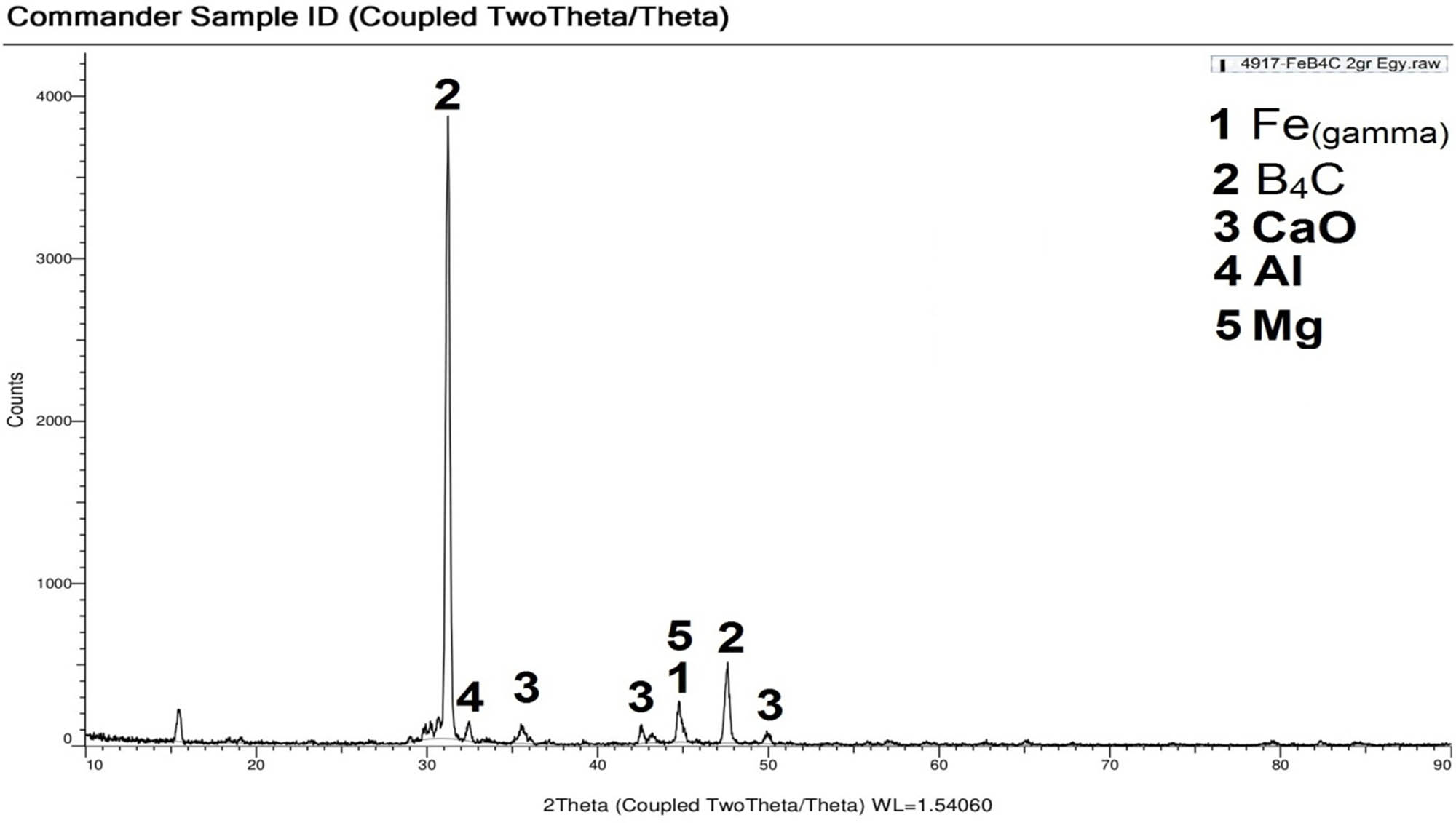
XRD analysis of 91.66% Fe–1.66% B4C–6.66% egg shelter.
5 Conclusion
In this study, five different compositions prepared were sintered at 1,400°C, and they were examined and characterized physically, mechanically and metallographically. Re-use of egg shells will pave the way for their use in different areas of industry, as it reduces the risk of microbiological problems and environmental pollution. In this study, powders obtained from egg shells by powder metallurgy technique were evaluated in composite production. This article proposes an alternative with the use of egg shell powders in the production of composites by powder metallurgy method.
Acknowledgment
This study was supported by the Scientific Research Projects Unit with the project numbered 15.Teknoloji.04.
-
Funding information: This research was funded by A.K.U. BAPK.
-
Author contributions: Conceptualization, A.Y. and A.E.; methodology, A.Y. and A.E; formal analysis, A.Y. and G.P.; investigation, A.Y. and G.P.; resources, A.Y. and G.P.; data curation, A.Y; writing – original draft preparation, A.Y. and A.E.; writing – review and editing, A.Y. and A.E. All authors have read and agreed to the published version of the manuscript.
-
Conflicts of interest: The authors declare no conflict of interest.
-
Data availability statement: The processed data necessary to reproduce these findings are available upon request with permission.
-
Ethical approval: Ethical approval is not required, as the study was not performed in vivo.
References
[1] Singh S, Gangwar S, Yadav S. A review on mechanical and tribological properties of Micro/Nano filled metal alloy composites. Mater Today Proc. 2017;4(4):5583–92.10.1016/j.matpr.2017.06.015Search in Google Scholar
[2] Özkan V, Sarpün İH, Erol A, Yönetken A. Influence of mean grain size with ultrasonic velocity on micro-hardness of B4C–Fe–Ni composite. J Alloy Compd. 2013;574:512–9.10.1016/j.jallcom.2013.05.097Search in Google Scholar
[3] Ünal R, Sarpün IH, Yalım HA, Erol A, Özdemir T, Tuncel S. The mean grain size determination of boron carbide (B4C)–aluminium (Al) and boron carbide (B4C)–nickel (Ni) composites by ultrasonic velocity technique. Mater Charact. 2006;56(3):241–4.10.1016/j.matchar.2005.11.006Search in Google Scholar
[4] Malıdarreh RB, Akkurt İ, Günoğlu K, Akyıldırım H. Fast neutrons shielding properties for Fe2O3 added composite. Int J Computational Exp Sci Eng. 2021;7(3):143–5. 10.22399/ijcesen.1012039.Search in Google Scholar
[5] Malidarreh Boodaghi R, Akkurt I, Malidarreh Boodaghi P, Arslankaya S. Investigation and ANN-based prediction of the radiation shielding, structural and mechanical properties of the Hydroxyapatite (HAP) bio-composite as artificial bone. Radiat Phys Chem. 2022;197:1–11.10.1016/j.radphyschem.2022.110208Search in Google Scholar
[6] Ozhan Doğan S, Özden T. Optimization of welding application parameters of thin sheet blocks used in the new-generation ship hull. Emerg Mater Res. 2022;1(11):67–75.10.1680/jemmr.20.00330Search in Google Scholar
[7] Gunoglu K, Özkavaka V, Akkurt İ. Evaluation of gamma ray attenuation properties of boron carbide (B4C) doped AISI 316 stainless steel: Experimental, XCOM and Phy-X/PSD database software. Mater Today Commun. 2021;29:102793. 10.1016/j.mtcomm.2021.102793.Search in Google Scholar
[8] Akkurt I, Malidarre RB. Physical, structural, and mechanical properties of the concrete by Fluka code and phy-X/PSD software. Radiat Phys Chem. 2022;193:1–10.10.1016/j.radphyschem.2021.109958Search in Google Scholar
[9] Arslankaya Çelik SMT. Green supplier selection in steel door industry using fuzzy AHP and fuzzy Moora methods. Emerg Mater Res. 2021;4(10):357–69.10.1680/jemmr.21.00011Search in Google Scholar
[10] Jawad AA, Demirkol N, Gunoğlu K, Akkurt I. Radiation shielding properties of some ceramic wasted samples. Int J Env Sci Technol. 2019;16(9):5039–42.10.1007/s13762-019-02240-7Search in Google Scholar
[11] Akkurt İ, Emıkönel S, Akarslan F, Günoğlu K, Kilinçarslan Ş, Üncü İS. Barite effect on radiation shielding properties of cotton - polyester fabric. Acta Phys Pol A. 2015 Aug;128(2-B):B53–4.10.12693/APhysPolA.128.B-53Search in Google Scholar
[12] Al-Obaidi S, Akyıldırım H, Gunoglu K, Akkurt I. Neutron shielding calculation for Barite-Boron-Water. Acta Phys Polonica A. 2020;137:551–3. 10.12693/APhysPolA.137.551.Search in Google Scholar
[13] Akkurt I, Basyigit C, Kilincarslan S, Beycioglu A. Prediction of photon attenuation coefficients of heavy concrete by fuzzy logic. J Frankl Inst. 2010;347(9):1589–97.10.1016/j.jfranklin.2010.06.002Search in Google Scholar
[14] Hanfi MY, Sayyed MI, Lacomme E, Akkurt I, Mahmoud KA. The influence of MgO on the radiation protection and mechanical properties of tellurite glasses. Nucl Eng Technol. 2021 Jun;53(6):2000–10.10.1016/j.net.2020.12.012Search in Google Scholar
[15] Akkurt I, Canakci H. Radiation attenuation of boron doped clay for 662, 1173 and 1332 keV gamma rays. Int J Radiat Res. 2011;9(1):37–40.Search in Google Scholar
[16] Al-Sarraya E, Akkurt İ, Günoğlu K, Evcin A, Bezir NÇ. Radiation Shielding Properties of Some Composite Panel. Acta Phys Pol A. 2017;132(3):490–2.10.12693/APhysPolA.132.490Search in Google Scholar
[17] Demir N, Tarim UA, Popovici MA, Demirci ZN, Gurler O, Akkurt I. Investigation of mass attenuation coefficients of water, concrete and bakelite at different energies using the FLUKA Monte Carlo code. J Radioanal Nucl Chem. 2013;298(2):1303–7.10.1007/s10967-013-2494-ySearch in Google Scholar
[18] Akkurt I, Akyıldırım H, Karipçin F, Mavi B. Chemical corrosion on gamma-ray attenuation properties of barite concrete. J Saudi Chem Soc. 2012;16(2):199–202. 10.1016/j.jscs.2011.01.003.Search in Google Scholar
[19] Kayiran HF. Numerical analysis of composite discs with carbon/epoxy and aramid/epoxy materials. Emerg Mater Res. 2022;11(1):155–9. 10.1680/jemmr.21.00052.Search in Google Scholar
[20] Kulali F. Simulation studies on radiological parameters for marble concrete. Emerg Mater Res. 2020;9(4):1341–7. 10.1680/jemmr.20.00307.Search in Google Scholar
[21] Malidarrea RB, Kulali F, Inal A, Oz A. Monte Carlo simulation of the Waste Soda-Lime-Silica Glass system contained Sb2O3. Emerg Mater Res. 2020;9(4):1334–40. 10.1680/jemmr.20.00202.Search in Google Scholar
[22] Akkurt I, Tekin HO. radiological parameters for bismuth oxide glasses using phy-X/PSD software. Emerg Mater Res. 2020;9(3):1020–7. 10.1680/jemmr.20.00209.Search in Google Scholar
[23] Rammah YS, Kumar A, Mahmoud KA, El-Mallawany R, El-Agawany FI, Susoy G, et al. SnO-reinforced silicate glasses and utilization in gamma-radiation-shielding applications. Emerg Mater Res. 2020;93:1000–8. 10.1680/jemmr.20.00150.Search in Google Scholar
[24] Tekin HO, Issa SAM, Mahmoud KA, El-Agawany FI, Rammah YS, Susoy G, et al. Nuclear radiation shielding competences of Barium (Ba) reinforced borosilicate glasses. Emerg Mater Res. 2020;9(4):1131–44. 10.1680/jemmr.20.00185.Search in Google Scholar
[25] Çelen YY, Evcin A. Synthesis and characterizations of magnetite–borogypsum for radiation shielding. Emerg Mater Res. 2020;93:770–5. 10.1680/jemmr.20.00098.Search in Google Scholar
[26] Çelen YY. Gamma ray shielding parameters of some phantom fabrication materials for medical dosimetry. Emerg Mater Res. 2021;10(3):307–13.10.1680/jemmr.21.00043Search in Google Scholar
[27] El-Agawany FI, Mahmoud KA, Akyildirim H, Yousef ES, Tekin HO, Rammah YS. Physical, neutron, and gamma-rays shielding parameters for Na2O–SiO2–PbO glasses. Emerg Mater Res. 2021;102:227–37.10.1680/jemmr.20.00297Search in Google Scholar
[28] Arslankaya S. Estimation of hanging and removal times in eloxal with artificial neural networks. Emerg Mater Res. 2020;9(2):366–74.10.1680/jemmr.19.00191Search in Google Scholar
[29] Arslankaya S. Estimating the effects of heat treatment on aluminum alloy with artificial neural networks. Emerg Mater Res. 2020;9(2):540–9.10.1680/jemmr.20.00059Search in Google Scholar
[30] Malidarre RB, Arslankaya S, Nar M, Yasin KI, Karpuz N, Dogan SO, et al. Deep learning prediction of gamma-ray-attenuation behavior of KNN–LMN ceramics Emerging. Mater Res. 2022;11(2):1–7.10.1680/jemmr.22.00012Search in Google Scholar
[31] Rajan TPD, Pillai RM, Pai BC. Reinforcement coatings and interfaces in aluminium metal matrix composites. J Mater Sci. 1998;33:3491–503.10.1023/A:1004674822751Search in Google Scholar
[32] Peng GY, Fang YS, Zhe ZJ, Chen WZ, Yu ZM. Preparation of active carbon with high specific surface area from rice husks. Chem Res Chin Univ. 2000;3.Search in Google Scholar
[33] Frage N, Froumin N, Dariel MP. Wetting of TiC by non-reactive liquid metals. Acta Mater. 2002;50(2):237–45.10.1016/S1359-6454(01)00349-4Search in Google Scholar
[34] Surip SN, Bonnia NN, Anuar H, Hassan NA, Yusof NM. Nanofibers from oil palm trunk (OPT): preparation & chemical analysis. Proceedings of the IEEE Symposium on Business, Engineering and Industrial Applications (ISBELA ’12). Bandung, Indonesia; 2012. p. 809–12.10.1109/ISBEIA.2012.6423003Search in Google Scholar
[35] Zakaria Z, Buniran S, Ishak MI. Nanopores activated carbon rice husk. Proceedings of the International Conference on Enabling Science and Nanotechnology (ESciNano ‘10). Kuala Lumpur, Malaysia, December, 2010. p. 1–2.10.1109/ESCINANO.2010.5701036Search in Google Scholar
[36] Yonetken A, Peşmen G, Erol A. Production and characterization of Ti-10Cr-3,33Co-3,33egg shelter composite materials using by powder metallurgy. Int J Eng Res Dev. 2020;12(1):158–65.10.29137/umagd.474031Search in Google Scholar
[37] Murakami FS, Rodrigues PO, Campos CM, Silva MA. Physicochemical study of CaCO3 from egg shells. Food Sci Technol (Camp). 2007;27(3):658–62.10.1590/S0101-20612007000300035Search in Google Scholar
[38] Boron L. Citrato de cálcio da casca do ovo: biodisponibilidade e uso como suplemento alimentar. UFSC, Florianópolis; 2004.Search in Google Scholar
[39] Ling IH, Teo DC. Lightweight concrete bricks produced from industrial and agricultural solid waste,. Proceedings of the World Congress on Sustainable Technologies (WCST ’11); 2011. p. 148–52.10.1109/WCST19361.2011.6114213Search in Google Scholar
[40] Yawar A, Samiullah T, Zilli HN, Israr B, Tufail T. Development and evaluation of calcium fortified date bars from indigenous sources. Int J Biosci. 2020;16(4):380–9.Search in Google Scholar
© 2022 Ahmet Yönetken et al., published by De Gruyter
This work is licensed under the Creative Commons Attribution 4.0 International License.
Articles in the same Issue
- Regular Articles
- Photocatalytic degradation of Rhodamine B in aqueous phase by bimetallic metal-organic framework M/Fe-MOF (M = Co, Cu, and Mg)
- Assessment of using electronic portal imaging device for analysing bolus material utilised in radiation therapy
- A detailed investigation on highly dense CuZr bulk metallic glasses for shielding purposes
- Simulation of gamma-ray shielding properties for materials of medical interest
- Environmental impact assesment regulation applications and their analysis in Turkey
- Sample age effect on parameters of dynamic nuclear polarization in certain difluorobenzen isomers/MC800 asphaltene suspensions
- Passenger demand forecasting for railway systems
- Design of a Robust sliding mode controller for bioreactor cultures in overflow metabolism via an interdisciplinary approach
- Gamma, neutron, and heavy charged ion shielding properties of Er3+-doped and Sm3+-doped zinc borate glasses
- Bridging chiral de-tert-butylcalix[4]arenes: Optical resolution based on column chromatography and structural characterization
- Petrology and geochemistry of multiphase post-granitic dikes: A case study from the Gabal Serbal area, Southwestern Sinai, Egypt
- Comparison of the yield and purity of plasma exosomes extracted by ultracentrifugation, precipitation, and membrane-based approaches
- Bioactive triterpenoids from Indonesian medicinal plant Syzygium aqueum
- Investigation of the effects of machining parameters on surface integrity in micromachining
- The mesoporous aluminosilicate application as support for bifunctional catalysts for n-hexadecane hydroconversion
- Gamma-ray shielding properties of Nd2O3-added iron–boron–phosphate-based composites
- Numerical investigation on perforated sheet metals under tension loading
- Statistical analysis on the radiological assessment and geochemical studies of granite rocks in the north of Um Taghir area, Eastern Desert, Egypt
- Two new polypodane-type bicyclic triterpenoids from mastic
- Structural, physical, and mechanical properties of the TiO2 added hydroxyapatite composites
- Tribological properties and characterization of borided Co–Mg alloys
- Studies on Anemone nemorosa L. extracts; polyphenols profile, antioxidant activity, and effects on Caco-2 cells by in vitro and in silico studies
- Mechanical properties, elastic moduli, transmission factors, and gamma-ray-shielding performances of Bi2O3–P2O5–B2O3–V2O5 quaternary glass system
- Cyclic connectivity index of bipolar fuzzy incidence graph
- The role of passage numbers of donor cells in the development of Arabian Oryx – Cow interspecific somatic cell nuclear transfer embryos
- Mechanical property evaluation of tellurite–germanate glasses and comparison of their radiation-shielding characteristics using EPICS2017 to other glass systems
- Molecular screening of ionic liquids for CO2 absorption and molecular dynamic simulation
- Microwave-assisted preparation of Ag/Fe magnetic biochar from clivia leaves for adsorbing daptomycin antibiotics
- Iminodisuccinic acid enhances antioxidant and mineral element accumulation in young leaves of Ziziphus jujuba
- Cytotoxic activity of guaiane-type sesquiterpene lactone (deoxycynaropicrin) isolated from the leaves of Centaurothamnus maximus
- Effects of welding parameters on the angular distortion of welded steel plates
- Simulation of a reactor considering the Stamicarbon, Snamprogetti, and Toyo patents for obtaining urea
- Effect of different ramie (Boehmeria nivea L. Gaud) cultivars on the adsorption of heavy metal ions cadmium and lead in the remediation of contaminated farmland soils
- Impact of a live bacterial-based direct-fed microbial (DFM) postpartum and weaning system on performance, mortality, and health of Najdi lambs
- Anti-tumor effect of liposomes containing extracted Murrayafoline A against liver cancer cells in 2D and 3D cultured models
- Physicochemical properties and some mineral concentration of milk samples from different animals and altitudes
- Copper(ii) complexes supported by modified azo-based ligands: Nucleic acid binding and molecular docking studies
- Diagnostic and therapeutic radioisotopes in nuclear medicine: Determination of gamma-ray transmission factors and safety competencies of high-dense and transparent glassy shields
- Calculation of NaI(Tl) detector efficiency using 226Ra, 232Th, and 40K radioisotopes: Three-phase Monte Carlo simulation study
- Isolation and identification of unstable components from Caesalpinia sappan by high-speed counter-current chromatography combined with preparative high-performance liquid chromatography
- Quantification of biomarkers and evaluation of antioxidant, anti-inflammatory, and cytotoxicity properties of Dodonaea viscosa grown in Saudi Arabia using HPTLC technique
- Characterization of the elastic modulus of ceramic–metal composites with physical and mechanical properties by ultrasonic technique
- GC-MS analysis of Vespa velutina auraria Smith and its anti-inflammatory and antioxidant activities in vitro
- Texturing of nanocoatings for surface acoustic wave-based sensors for volatile organic compounds
- Insights into the molecular basis of some chalcone analogues as potential inhibitors of Leishmania donovani: An integrated in silico and in vitro study
- (1R,2S,5R)-5-Methyl-2-(propan-2-yl)cyclohexyl 4-amino-3-phenylbutanoate hydrochloride: Synthesis and anticonvulsant activity
- On the relative extraction rates of colour compounds and caffeine during brewing, an investigation of tea over time and temperature
- Characterization of egg shell powder-doped ceramic–metal composites
- Rapeseed oil-based hippurate amide nanocomposite coating material for anticorrosive and antibacterial applications
- Chemically modified Teucrium polium (Lamiaceae) plant act as an effective adsorbent tool for potassium permanganate (KMnO4) in wastewater remediation
- Efficiency analysis of photovoltaic systems installed in different geographical locations
- Risk prioritization model driven by success factor in the light of multicriteria decision making
- Theoretical investigations on the excited-state intramolecular proton transfer in the solvated 2-hydroxy-1-naphthaldehyde carbohydrazone
- Mechanical and gamma-ray shielding examinations of Bi2O3–PbO–CdO–B2O3 glass system
- Machine learning-based forecasting of potability of drinking water through adaptive boosting model
- The potential effect of the Rumex vesicarius water seeds extract treatment on mice before and during pregnancy on the serum enzymes and the histology of kidney and liver
- Impact of benzimidazole functional groups on the n-doping properties of benzimidazole derivatives
- Extraction of red pigment from Chinese jujube peel and the antioxidant activity of the pigment extracts
- Flexural strength and thermal properties of carbon black nanoparticle reinforced epoxy composites obtained from waste tires
- A focusing study on radioprotective and antioxidant effects of Annona muricata leaf extract in the circulation and liver tissue: Clinical and experimental studies
- Clinical comprehensive and experimental assessment of the radioprotective effect of Annona muricata leaf extract to prevent cellular damage in the ileum tissue
- Effect of WC content on ultrasonic properties, thermal and electrical conductivity of WC–Co–Ni–Cr composites
- Influence of various class cleaning agents for prosthesis on Co–Cr alloy surface
- The synthesis of nanocellulose-based nanocomposites for the effective removal of hexavalent chromium ions from aqueous solution
- Study on the influence of physical interlayers on the remaining oil production under different development modes
- Optimized linear regression control of DC motor under various disturbances
- Influence of different sample preparation strategies on hypothesis-driven shotgun proteomic analysis of human saliva
- Determination of flow distance of the fluid metal due to fluidity in ductile iron casting by artificial neural networks approach
- Investigation of mechanical activation effect on high-volume natural pozzolanic cements
- In vitro: Anti-coccidia activity of Calotropis procera leaf extract on Eimeria papillata oocysts sporulation and sporozoite
- Determination of oil composition of cowpea (Vigna unguiculata L.) seeds under influence of organic fertilizer forms
- Activated partial thromboplastin time maybe associated with the prognosis of papillary thyroid carcinoma
- Treatment of rat brain ischemia model by NSCs-polymer scaffold transplantation
- Lead and cadmium removal with native yeast from coastal wetlands
- Characterization of electroless Ni-coated Fe–Co composite using powder metallurgy
- Ferrate synthesis using NaOCl and its application for dye removal
- Antioxidant, antidiabetic, and anticholinesterase potential of Chenopodium murale L. extracts using in vitro and in vivo approaches
- Study on essential oil, antioxidant activity, anti-human prostate cancer effects, and induction of apoptosis by Equisetum arvense
- Experimental study on turning machine with permanent magnetic cutting tool
- Numerical simulation and mathematical modeling of the casting process for pearlitic spheroidal graphite cast iron
- Design, synthesis, and cytotoxicity evaluation of novel thiophene, pyrimidine, pyridazine, and pyridine: Griseofulvin heterocyclic extension derivatives
- Isolation and identification of promising antibiotic-producing bacteria
- Ultrasonic-induced reversible blood–brain barrier opening: Safety evaluation into the cellular level
- Evaluation of phytochemical and antioxidant potential of various extracts from traditionally used medicinal plants of Pakistan
- Effect of calcium lactate in standard diet on selected markers of oxidative stress and inflammation in ovariectomized rats
- Identification of crucial salivary proteins/genes and pathways involved in pathogenesis of temporomandibular disorders
- Zirconium-modified attapulgite was used for removing of Cr(vi) in aqueous solution
- The stress distribution of different types of restorative materials in primary molar
- Reducing surface heat loss in steam boilers
- Deformation behavior and formability of friction stir processed DP600 steel
- Synthesis and characterization of bismuth oxide/commercial activated carbon composite for battery anode
- Phytochemical analysis of Ziziphus jujube leaf at different foliar ages based on widely targeted metabolomics
- Effects of in ovo injection of black cumin (Nigella sativa) extract on hatching performance of broiler eggs
- Separation and evaluation of potential antioxidant, analgesic, and anti-inflammatory activities of limonene-rich essential oils from Citrus sinensis (L.)
- Bioactivity of a polyhydroxy gorgostane steroid from Xenia umbellata
- BiCAM-based automated scoring system for digital logic circuit diagrams
- Analysis of standard systems with solar monitoring systems
- Structural and spectroscopic properties of voriconazole and fluconazole – Experimental and theoretical studies
- New plant resistance inducers based on polyamines
- Experimental investigation of single-lap bolted and bolted/bonded (hybrid) joints of polymeric plates
- Investigation of inlet air pressure and evaporative cooling of four different cogeneration cycles
- Review Articles
- Comprehensive review on synthesis, physicochemical properties, and application of activated carbon from the Arecaceae plants for enhanced wastewater treatment
- Research progress on speciation analysis of arsenic in traditional Chinese medicine
- Recent modified air-assisted liquid–liquid microextraction applications for medicines and organic compounds in various samples: A review
- An insight on Vietnamese bio-waste materials as activated carbon precursors for multiple applications in environmental protection
- Antimicrobial activities of the extracts and secondary metabolites from Clausena genus – A review
- Bioremediation of organic/heavy metal contaminants by mixed cultures of microorganisms: A review
- Sonodynamic therapy for breast cancer: A literature review
- Recent progress of amino acid transporters as a novel antitumor target
- Aconitum coreanum Rapaics: Botany, traditional uses, phytochemistry, pharmacology, and toxicology
- Corrigendum
- Corrigendum to “Petrology and geochemistry of multiphase post-granitic dikes: A case study from the Gabal Serbal area, Southwestern Sinai, Egypt”
- Corrigendum to “Design of a Robust sliding mode controller for bioreactor cultures in overflow metabolism via an interdisciplinary approach”
- Corrigendum to “Statistical analysis on the radiological assessment and geochemical studies of granite rocks in the north of Um Taghir area, Eastern Desert, Egypt”
- Corrigendum to “Aroma components of tobacco powder from different producing areas based on gas chromatography ion mobility spectrometry”
- Corrigendum to “Mechanical properties, elastic moduli, transmission factors, and gamma-ray-shielding performances of Bi2O3–P2O5–B2O3–V2O5 quaternary glass system”
- Erratum
- Erratum to “Copper(ii) complexes supported by modified azo-based ligands: Nucleic acid binding and molecular docking studies”
- Special Issue on Applied Biochemistry and Biotechnology (ABB 2021)
- Study of solidification and stabilization of heavy metals by passivators in heavy metal-contaminated soil
- Human health risk assessment and distribution of VOCs in a chemical site, Weinan, China
- Preparation and characterization of Sparassis latifolia β-glucan microcapsules
- Special Issue on the Conference of Energy, Fuels, Environment 2020
- Improving the thermal performance of existing buildings in light of the requirements of the EU directive 2010/31/EU in Poland
- Special Issue on Ethnobotanical, Phytochemical and Biological Investigation of Medicinal Plants
- Study of plant resources with ethnomedicinal relevance from district Bagh, Azad Jammu and Kashmir, Pakistan
- Studies on the chemical composition of plants used in traditional medicine in Congo
- Special Issue on Applied Chemistry in Agriculture and Food Science
- Strip spraying technology for precise herbicide application in carrot fields
- Special Issue on Pharmacology and Metabolomics of Ethnobotanical and Herbal Medicine
- Phytochemical profiling, antibacterial and antioxidant properties of Crocus sativus flower: A comparison between tepals and stigmas
- Antioxidant and antimicrobial properties of polyphenolics from Withania adpressa (Coss.) Batt. against selected drug-resistant bacterial strains
- Integrating network pharmacology and molecular docking to explore the potential mechanism of Xinguan No. 3 in the treatment of COVID-19
- Chemical composition and in vitro and in vivo biological assortment of fixed oil extracted from Ficus benghalensis L.
- A review of the pharmacological activities and protective effects of Inonotus obliquus triterpenoids in kidney diseases
- Ethnopharmacological study of medicinal plants in Kastamonu province (Türkiye)
- Protective effects of asperuloside against cyclophosphamide-induced urotoxicity and hematotoxicity in rats
- Special Issue on Essential Oil, Extraction, Phytochemistry, Advances, and Application
- Identification of volatile compounds and antioxidant, antibacterial, and antifungal properties against drug-resistant microbes of essential oils from the leaves of Mentha rotundifolia var. apodysa Briq. (Lamiaceae)
- Phenolic contents, anticancer, antioxidant, and antimicrobial capacities of MeOH extract from the aerial parts of Trema orientalis plant
- Chemical composition and antimicrobial activity of essential oils from Mentha pulegium and Rosmarinus officinalis against multidrug-resistant microbes and their acute toxicity study
- Special Issue on Marine Environmental Sciences and Significance of the Multidisciplinary Approaches
- An insightful overview of the distribution pattern of polycyclic aromatic hydrocarbon in the marine sediments of the Red Sea
- Antifungal–antiproliferative norcycloartane-type triterpenes from the Red Sea green alga Tydemania expeditionis
- Solvent effect, dipole moment, and DFT studies of multi donor–acceptor type pyridine derivative
- An extensive assessment on the distribution pattern of organic contaminants in the aerosols samples in the Middle East
- Special Issue on 4th IC3PE
- Energetics of carboxylic acid–pyridine heterosynthon revisited: A computational study of intermolecular hydrogen bond domination on phenylacetic acid–nicotinamide cocrystals
- A review: Silver–zinc oxide nanoparticles – organoclay-reinforced chitosan bionanocomposites for food packaging
- Green synthesis of magnetic activated carbon from peanut shells functionalized with TiO2 photocatalyst for Batik liquid waste treatment
- Coagulation activity of liquid extraction of Leucaena leucocephala and Sesbania grandiflora on the removal of turbidity
- Hydrocracking optimization of palm oil over NiMoO4/activated carbon catalyst to produce biogasoline and kerosine
- Special Issue on Pharmacology and metabolomics of ethnobotanical and herbal medicine
- Cynarin inhibits PDGF-BB-induced proliferation and activation in hepatic stellate cells through PPARγ
- Special Issue on The 1st Malaysia International Conference on Nanotechnology & Catalysis (MICNC2021)
- Surfactant evaluation for enhanced oil recovery: Phase behavior and interfacial tension
- Topical Issue on phytochemicals, biological and toxicological analysis of aromatic medicinal plants
- Phytochemical analysis of leaves and stems of Physalis alkekengi L. (Solanaceae)
- Phytochemical and pharmacological profiling of Trewia nudiflora Linn. leaf extract deciphers therapeutic potentials against thrombosis, arthritis, helminths, and insects
- Pergularia tomentosa coupled with selenium nanoparticles salvaged lead acetate-induced redox imbalance, inflammation, apoptosis, and disruption of neurotransmission in rats’ brain
- Protective effect of Allium atroviolaceum-synthesized SeNPs on aluminum-induced brain damage in mice
- Mechanism study of Cordyceps sinensis alleviates renal ischemia–reperfusion injury
- Plant-derived bisbenzylisoquinoline alkaloid tetrandrine prevents human podocyte injury by regulating the miR-150-5p/NPHS1 axis
- Network pharmacology combined with molecular docking to explore the anti-osteoporosis mechanisms of β-ecdysone derived from medicinal plants
- Chinese medicinal plant Polygonum cuspidatum ameliorates silicosis via suppressing the Wnt/β-catenin pathway
- Special Issue on Advanced Nanomaterials for Energy, Environmental and Biological Applications - Part I
- Investigation of improved optical and conductivity properties of poly(methyl methacrylate)–MXenes (PMMA–MXenes) nanocomposite thin films for optoelectronic applications
- Special Issue on Applied Biochemistry and Biotechnology (ABB 2022)
- Model predictive control for precision irrigation of a Quinoa crop
Articles in the same Issue
- Regular Articles
- Photocatalytic degradation of Rhodamine B in aqueous phase by bimetallic metal-organic framework M/Fe-MOF (M = Co, Cu, and Mg)
- Assessment of using electronic portal imaging device for analysing bolus material utilised in radiation therapy
- A detailed investigation on highly dense CuZr bulk metallic glasses for shielding purposes
- Simulation of gamma-ray shielding properties for materials of medical interest
- Environmental impact assesment regulation applications and their analysis in Turkey
- Sample age effect on parameters of dynamic nuclear polarization in certain difluorobenzen isomers/MC800 asphaltene suspensions
- Passenger demand forecasting for railway systems
- Design of a Robust sliding mode controller for bioreactor cultures in overflow metabolism via an interdisciplinary approach
- Gamma, neutron, and heavy charged ion shielding properties of Er3+-doped and Sm3+-doped zinc borate glasses
- Bridging chiral de-tert-butylcalix[4]arenes: Optical resolution based on column chromatography and structural characterization
- Petrology and geochemistry of multiphase post-granitic dikes: A case study from the Gabal Serbal area, Southwestern Sinai, Egypt
- Comparison of the yield and purity of plasma exosomes extracted by ultracentrifugation, precipitation, and membrane-based approaches
- Bioactive triterpenoids from Indonesian medicinal plant Syzygium aqueum
- Investigation of the effects of machining parameters on surface integrity in micromachining
- The mesoporous aluminosilicate application as support for bifunctional catalysts for n-hexadecane hydroconversion
- Gamma-ray shielding properties of Nd2O3-added iron–boron–phosphate-based composites
- Numerical investigation on perforated sheet metals under tension loading
- Statistical analysis on the radiological assessment and geochemical studies of granite rocks in the north of Um Taghir area, Eastern Desert, Egypt
- Two new polypodane-type bicyclic triterpenoids from mastic
- Structural, physical, and mechanical properties of the TiO2 added hydroxyapatite composites
- Tribological properties and characterization of borided Co–Mg alloys
- Studies on Anemone nemorosa L. extracts; polyphenols profile, antioxidant activity, and effects on Caco-2 cells by in vitro and in silico studies
- Mechanical properties, elastic moduli, transmission factors, and gamma-ray-shielding performances of Bi2O3–P2O5–B2O3–V2O5 quaternary glass system
- Cyclic connectivity index of bipolar fuzzy incidence graph
- The role of passage numbers of donor cells in the development of Arabian Oryx – Cow interspecific somatic cell nuclear transfer embryos
- Mechanical property evaluation of tellurite–germanate glasses and comparison of their radiation-shielding characteristics using EPICS2017 to other glass systems
- Molecular screening of ionic liquids for CO2 absorption and molecular dynamic simulation
- Microwave-assisted preparation of Ag/Fe magnetic biochar from clivia leaves for adsorbing daptomycin antibiotics
- Iminodisuccinic acid enhances antioxidant and mineral element accumulation in young leaves of Ziziphus jujuba
- Cytotoxic activity of guaiane-type sesquiterpene lactone (deoxycynaropicrin) isolated from the leaves of Centaurothamnus maximus
- Effects of welding parameters on the angular distortion of welded steel plates
- Simulation of a reactor considering the Stamicarbon, Snamprogetti, and Toyo patents for obtaining urea
- Effect of different ramie (Boehmeria nivea L. Gaud) cultivars on the adsorption of heavy metal ions cadmium and lead in the remediation of contaminated farmland soils
- Impact of a live bacterial-based direct-fed microbial (DFM) postpartum and weaning system on performance, mortality, and health of Najdi lambs
- Anti-tumor effect of liposomes containing extracted Murrayafoline A against liver cancer cells in 2D and 3D cultured models
- Physicochemical properties and some mineral concentration of milk samples from different animals and altitudes
- Copper(ii) complexes supported by modified azo-based ligands: Nucleic acid binding and molecular docking studies
- Diagnostic and therapeutic radioisotopes in nuclear medicine: Determination of gamma-ray transmission factors and safety competencies of high-dense and transparent glassy shields
- Calculation of NaI(Tl) detector efficiency using 226Ra, 232Th, and 40K radioisotopes: Three-phase Monte Carlo simulation study
- Isolation and identification of unstable components from Caesalpinia sappan by high-speed counter-current chromatography combined with preparative high-performance liquid chromatography
- Quantification of biomarkers and evaluation of antioxidant, anti-inflammatory, and cytotoxicity properties of Dodonaea viscosa grown in Saudi Arabia using HPTLC technique
- Characterization of the elastic modulus of ceramic–metal composites with physical and mechanical properties by ultrasonic technique
- GC-MS analysis of Vespa velutina auraria Smith and its anti-inflammatory and antioxidant activities in vitro
- Texturing of nanocoatings for surface acoustic wave-based sensors for volatile organic compounds
- Insights into the molecular basis of some chalcone analogues as potential inhibitors of Leishmania donovani: An integrated in silico and in vitro study
- (1R,2S,5R)-5-Methyl-2-(propan-2-yl)cyclohexyl 4-amino-3-phenylbutanoate hydrochloride: Synthesis and anticonvulsant activity
- On the relative extraction rates of colour compounds and caffeine during brewing, an investigation of tea over time and temperature
- Characterization of egg shell powder-doped ceramic–metal composites
- Rapeseed oil-based hippurate amide nanocomposite coating material for anticorrosive and antibacterial applications
- Chemically modified Teucrium polium (Lamiaceae) plant act as an effective adsorbent tool for potassium permanganate (KMnO4) in wastewater remediation
- Efficiency analysis of photovoltaic systems installed in different geographical locations
- Risk prioritization model driven by success factor in the light of multicriteria decision making
- Theoretical investigations on the excited-state intramolecular proton transfer in the solvated 2-hydroxy-1-naphthaldehyde carbohydrazone
- Mechanical and gamma-ray shielding examinations of Bi2O3–PbO–CdO–B2O3 glass system
- Machine learning-based forecasting of potability of drinking water through adaptive boosting model
- The potential effect of the Rumex vesicarius water seeds extract treatment on mice before and during pregnancy on the serum enzymes and the histology of kidney and liver
- Impact of benzimidazole functional groups on the n-doping properties of benzimidazole derivatives
- Extraction of red pigment from Chinese jujube peel and the antioxidant activity of the pigment extracts
- Flexural strength and thermal properties of carbon black nanoparticle reinforced epoxy composites obtained from waste tires
- A focusing study on radioprotective and antioxidant effects of Annona muricata leaf extract in the circulation and liver tissue: Clinical and experimental studies
- Clinical comprehensive and experimental assessment of the radioprotective effect of Annona muricata leaf extract to prevent cellular damage in the ileum tissue
- Effect of WC content on ultrasonic properties, thermal and electrical conductivity of WC–Co–Ni–Cr composites
- Influence of various class cleaning agents for prosthesis on Co–Cr alloy surface
- The synthesis of nanocellulose-based nanocomposites for the effective removal of hexavalent chromium ions from aqueous solution
- Study on the influence of physical interlayers on the remaining oil production under different development modes
- Optimized linear regression control of DC motor under various disturbances
- Influence of different sample preparation strategies on hypothesis-driven shotgun proteomic analysis of human saliva
- Determination of flow distance of the fluid metal due to fluidity in ductile iron casting by artificial neural networks approach
- Investigation of mechanical activation effect on high-volume natural pozzolanic cements
- In vitro: Anti-coccidia activity of Calotropis procera leaf extract on Eimeria papillata oocysts sporulation and sporozoite
- Determination of oil composition of cowpea (Vigna unguiculata L.) seeds under influence of organic fertilizer forms
- Activated partial thromboplastin time maybe associated with the prognosis of papillary thyroid carcinoma
- Treatment of rat brain ischemia model by NSCs-polymer scaffold transplantation
- Lead and cadmium removal with native yeast from coastal wetlands
- Characterization of electroless Ni-coated Fe–Co composite using powder metallurgy
- Ferrate synthesis using NaOCl and its application for dye removal
- Antioxidant, antidiabetic, and anticholinesterase potential of Chenopodium murale L. extracts using in vitro and in vivo approaches
- Study on essential oil, antioxidant activity, anti-human prostate cancer effects, and induction of apoptosis by Equisetum arvense
- Experimental study on turning machine with permanent magnetic cutting tool
- Numerical simulation and mathematical modeling of the casting process for pearlitic spheroidal graphite cast iron
- Design, synthesis, and cytotoxicity evaluation of novel thiophene, pyrimidine, pyridazine, and pyridine: Griseofulvin heterocyclic extension derivatives
- Isolation and identification of promising antibiotic-producing bacteria
- Ultrasonic-induced reversible blood–brain barrier opening: Safety evaluation into the cellular level
- Evaluation of phytochemical and antioxidant potential of various extracts from traditionally used medicinal plants of Pakistan
- Effect of calcium lactate in standard diet on selected markers of oxidative stress and inflammation in ovariectomized rats
- Identification of crucial salivary proteins/genes and pathways involved in pathogenesis of temporomandibular disorders
- Zirconium-modified attapulgite was used for removing of Cr(vi) in aqueous solution
- The stress distribution of different types of restorative materials in primary molar
- Reducing surface heat loss in steam boilers
- Deformation behavior and formability of friction stir processed DP600 steel
- Synthesis and characterization of bismuth oxide/commercial activated carbon composite for battery anode
- Phytochemical analysis of Ziziphus jujube leaf at different foliar ages based on widely targeted metabolomics
- Effects of in ovo injection of black cumin (Nigella sativa) extract on hatching performance of broiler eggs
- Separation and evaluation of potential antioxidant, analgesic, and anti-inflammatory activities of limonene-rich essential oils from Citrus sinensis (L.)
- Bioactivity of a polyhydroxy gorgostane steroid from Xenia umbellata
- BiCAM-based automated scoring system for digital logic circuit diagrams
- Analysis of standard systems with solar monitoring systems
- Structural and spectroscopic properties of voriconazole and fluconazole – Experimental and theoretical studies
- New plant resistance inducers based on polyamines
- Experimental investigation of single-lap bolted and bolted/bonded (hybrid) joints of polymeric plates
- Investigation of inlet air pressure and evaporative cooling of four different cogeneration cycles
- Review Articles
- Comprehensive review on synthesis, physicochemical properties, and application of activated carbon from the Arecaceae plants for enhanced wastewater treatment
- Research progress on speciation analysis of arsenic in traditional Chinese medicine
- Recent modified air-assisted liquid–liquid microextraction applications for medicines and organic compounds in various samples: A review
- An insight on Vietnamese bio-waste materials as activated carbon precursors for multiple applications in environmental protection
- Antimicrobial activities of the extracts and secondary metabolites from Clausena genus – A review
- Bioremediation of organic/heavy metal contaminants by mixed cultures of microorganisms: A review
- Sonodynamic therapy for breast cancer: A literature review
- Recent progress of amino acid transporters as a novel antitumor target
- Aconitum coreanum Rapaics: Botany, traditional uses, phytochemistry, pharmacology, and toxicology
- Corrigendum
- Corrigendum to “Petrology and geochemistry of multiphase post-granitic dikes: A case study from the Gabal Serbal area, Southwestern Sinai, Egypt”
- Corrigendum to “Design of a Robust sliding mode controller for bioreactor cultures in overflow metabolism via an interdisciplinary approach”
- Corrigendum to “Statistical analysis on the radiological assessment and geochemical studies of granite rocks in the north of Um Taghir area, Eastern Desert, Egypt”
- Corrigendum to “Aroma components of tobacco powder from different producing areas based on gas chromatography ion mobility spectrometry”
- Corrigendum to “Mechanical properties, elastic moduli, transmission factors, and gamma-ray-shielding performances of Bi2O3–P2O5–B2O3–V2O5 quaternary glass system”
- Erratum
- Erratum to “Copper(ii) complexes supported by modified azo-based ligands: Nucleic acid binding and molecular docking studies”
- Special Issue on Applied Biochemistry and Biotechnology (ABB 2021)
- Study of solidification and stabilization of heavy metals by passivators in heavy metal-contaminated soil
- Human health risk assessment and distribution of VOCs in a chemical site, Weinan, China
- Preparation and characterization of Sparassis latifolia β-glucan microcapsules
- Special Issue on the Conference of Energy, Fuels, Environment 2020
- Improving the thermal performance of existing buildings in light of the requirements of the EU directive 2010/31/EU in Poland
- Special Issue on Ethnobotanical, Phytochemical and Biological Investigation of Medicinal Plants
- Study of plant resources with ethnomedicinal relevance from district Bagh, Azad Jammu and Kashmir, Pakistan
- Studies on the chemical composition of plants used in traditional medicine in Congo
- Special Issue on Applied Chemistry in Agriculture and Food Science
- Strip spraying technology for precise herbicide application in carrot fields
- Special Issue on Pharmacology and Metabolomics of Ethnobotanical and Herbal Medicine
- Phytochemical profiling, antibacterial and antioxidant properties of Crocus sativus flower: A comparison between tepals and stigmas
- Antioxidant and antimicrobial properties of polyphenolics from Withania adpressa (Coss.) Batt. against selected drug-resistant bacterial strains
- Integrating network pharmacology and molecular docking to explore the potential mechanism of Xinguan No. 3 in the treatment of COVID-19
- Chemical composition and in vitro and in vivo biological assortment of fixed oil extracted from Ficus benghalensis L.
- A review of the pharmacological activities and protective effects of Inonotus obliquus triterpenoids in kidney diseases
- Ethnopharmacological study of medicinal plants in Kastamonu province (Türkiye)
- Protective effects of asperuloside against cyclophosphamide-induced urotoxicity and hematotoxicity in rats
- Special Issue on Essential Oil, Extraction, Phytochemistry, Advances, and Application
- Identification of volatile compounds and antioxidant, antibacterial, and antifungal properties against drug-resistant microbes of essential oils from the leaves of Mentha rotundifolia var. apodysa Briq. (Lamiaceae)
- Phenolic contents, anticancer, antioxidant, and antimicrobial capacities of MeOH extract from the aerial parts of Trema orientalis plant
- Chemical composition and antimicrobial activity of essential oils from Mentha pulegium and Rosmarinus officinalis against multidrug-resistant microbes and their acute toxicity study
- Special Issue on Marine Environmental Sciences and Significance of the Multidisciplinary Approaches
- An insightful overview of the distribution pattern of polycyclic aromatic hydrocarbon in the marine sediments of the Red Sea
- Antifungal–antiproliferative norcycloartane-type triterpenes from the Red Sea green alga Tydemania expeditionis
- Solvent effect, dipole moment, and DFT studies of multi donor–acceptor type pyridine derivative
- An extensive assessment on the distribution pattern of organic contaminants in the aerosols samples in the Middle East
- Special Issue on 4th IC3PE
- Energetics of carboxylic acid–pyridine heterosynthon revisited: A computational study of intermolecular hydrogen bond domination on phenylacetic acid–nicotinamide cocrystals
- A review: Silver–zinc oxide nanoparticles – organoclay-reinforced chitosan bionanocomposites for food packaging
- Green synthesis of magnetic activated carbon from peanut shells functionalized with TiO2 photocatalyst for Batik liquid waste treatment
- Coagulation activity of liquid extraction of Leucaena leucocephala and Sesbania grandiflora on the removal of turbidity
- Hydrocracking optimization of palm oil over NiMoO4/activated carbon catalyst to produce biogasoline and kerosine
- Special Issue on Pharmacology and metabolomics of ethnobotanical and herbal medicine
- Cynarin inhibits PDGF-BB-induced proliferation and activation in hepatic stellate cells through PPARγ
- Special Issue on The 1st Malaysia International Conference on Nanotechnology & Catalysis (MICNC2021)
- Surfactant evaluation for enhanced oil recovery: Phase behavior and interfacial tension
- Topical Issue on phytochemicals, biological and toxicological analysis of aromatic medicinal plants
- Phytochemical analysis of leaves and stems of Physalis alkekengi L. (Solanaceae)
- Phytochemical and pharmacological profiling of Trewia nudiflora Linn. leaf extract deciphers therapeutic potentials against thrombosis, arthritis, helminths, and insects
- Pergularia tomentosa coupled with selenium nanoparticles salvaged lead acetate-induced redox imbalance, inflammation, apoptosis, and disruption of neurotransmission in rats’ brain
- Protective effect of Allium atroviolaceum-synthesized SeNPs on aluminum-induced brain damage in mice
- Mechanism study of Cordyceps sinensis alleviates renal ischemia–reperfusion injury
- Plant-derived bisbenzylisoquinoline alkaloid tetrandrine prevents human podocyte injury by regulating the miR-150-5p/NPHS1 axis
- Network pharmacology combined with molecular docking to explore the anti-osteoporosis mechanisms of β-ecdysone derived from medicinal plants
- Chinese medicinal plant Polygonum cuspidatum ameliorates silicosis via suppressing the Wnt/β-catenin pathway
- Special Issue on Advanced Nanomaterials for Energy, Environmental and Biological Applications - Part I
- Investigation of improved optical and conductivity properties of poly(methyl methacrylate)–MXenes (PMMA–MXenes) nanocomposite thin films for optoelectronic applications
- Special Issue on Applied Biochemistry and Biotechnology (ABB 2022)
- Model predictive control for precision irrigation of a Quinoa crop

